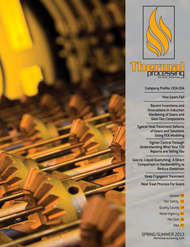Archives
September 2013
Inductive Spin Hardening of Gears: A Survey of Key Features and Benefits
A large part of the misunderstanding of induction hardening seems to stem from an incomplete grasp of the basic induction heating process. This is surprising, as the process itself is relatively easy to grasp once certain fundamental steps have been explained. Induction heating is quite literally heat that has been induced in a workpiece. Roughly […]
Properties of Cases Treated with High-Temperature Vacuum Carburization
Carburizing continues to be one of the basic thermochemical treatments used for industrial steel. With the development of the industry, carburizing has evolved from its simplest forms, such as pack treatment, to advanced vacuum technologies. At present, vacuum carburization technology is replacing the older technologies and is more and more widely used, especially in the […]
CASE STUDY: Company: Praxair Distribution, Inc. Customer: ALD Thermal Treatment, Inc.
In the past several years, heat treating companies have experienced a significant supply disruption in generated acetylene. Additionally, generated acetylene may not offer the purity required for important manufacturing processes such as the vacuum carburizing function of heat treating for gears. ALD Thermal Treatment Inc. (ALD) recognized the need to find a stable, reliable supply […]
Cures for Heat Treaters Headaches
Heat treaters all over the world encounter similar problems with atmosphere furnaces. These problems not only cause operational headaches in the daily lives of furnace personnel; they significantly affect the bottom line. The most common is creep distortion of alloy components under carburizing conditions, eventually leading to catastrophic failure. This paper explores both conventional and […]
Improving Production Safely with Integrated Heat Treat and Quenching Cell
These aspects are not just requested, but increasingly required by industrial clients looking to install new thermal systems or expand or enhance existing processes at their manufacturing facilities. This was particularly true of a global manufacturer for the aerospace industry in need of a custom-designed, fully automated heat treatment and material handling system. In early […]
Simulation of Gas Quenching of Steel Parts
One major difference between immersion quenching and gas quenching is the presence of boiling during the early stages of quenching in oil or water. The formation of a vapor phase has a significant effect on the overall and local heat removal rate from the parts being quenched and also on part distortion. With the absence […]
April 2013
How Gears Fail
Heat treatment plays an important — some would say critical — role in gear manufacturing. Therefore, there is a need to better understand, from the perspective of the heat treater, the contribution of heat treatment to gear failures. Aspects such as design, material, heat treatment, and service application all provide examples that serve as an […]
Recent Inventions and Innovations in Induction Hardening of Gears and Gear-like Components
This paper focuses on recent inventions and innovations (from the past four-six years) in induction hardening of gears and gear-like components, including, but not limited to: “Know-how” in controlling distortion of induction-hardened gears Simultaneous dual-frequency induction hardening Advanced induction-hardening process recipes when hardening small and medium size gears Novel inductor designs to minimize distortion when […]
Heat Treat Process For Gears
Heat treatment is a critical and complex element in the manufacturing of gears that greatly impacts how each will perform in transmitting power or carrying motion to other components in an assembly. Heat treatments optimize the performance and extend the life of gears in service by altering their chemical, metallurgical, and physical properties. These properties […]
Typical Heat Treatment Defects of Gears and Solutions Using FEA Modeling
Steel gears are heat treated to obtain enhanced properties and improved service performance. Quench hardening is one of the most important heat treatment processes used to increase the strength and hardness of steel parts. Defects seen in quenched parts are often due to high thermal and phase transformation stresses. Typical defects include excessive distortion, surface […]
Tighter Control Through Understanding What Your TUS Reports Are Telling You
Temperature uniformity is the temperature variation (usually expressed as ± degrees) within the qualified furnace work zone (Figure 1) with respect to a set point temperature. A TUS (temperature uniformity survey) is a test or series of tests where calibrated field test instrumentation and sensors are used to measure temperature variation within the qualified furnace […]
Gas vs. Liquid Quenching: A Direct Comparison in Hardenability to Reduce Distortion
Introduction Hardenability is the ability of steel to partially or completely transform from austenite to some fraction of martensite at a given depth below the surface when cooled under a certain condition. The “gold standard” test for all hardenability results has always been the Jominy End Quench Test. The information gained from this test is […]
Deep Cryogenic Treatment
What is deep cryogenic treatment? Deep cryogenic treatment (DCT) of steels and other materials is a distinct process that uses the application of extreme cold applied with distinct time/temperature profiles to modify the performance of materials. This process is also referred to as cryogenic processing, cryogenic tempering, deep cryogenic treatment, deep cryogenic tempering, and deep […]
























